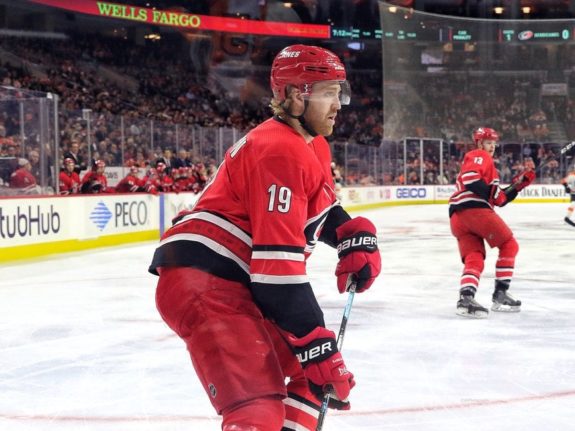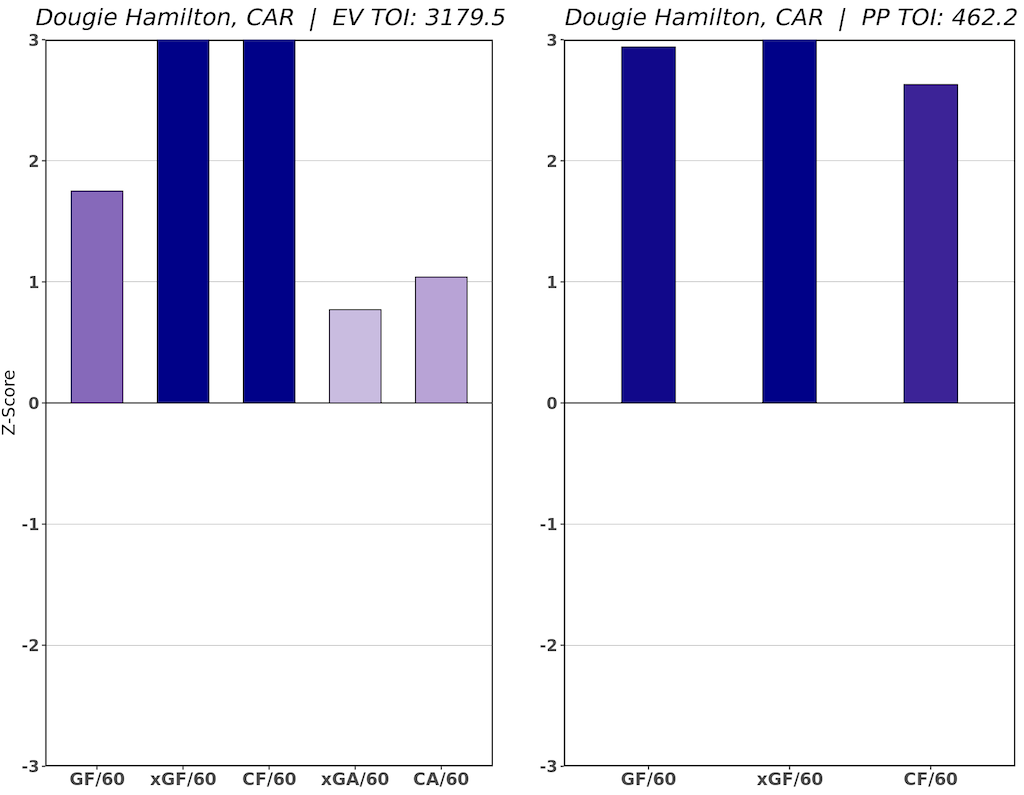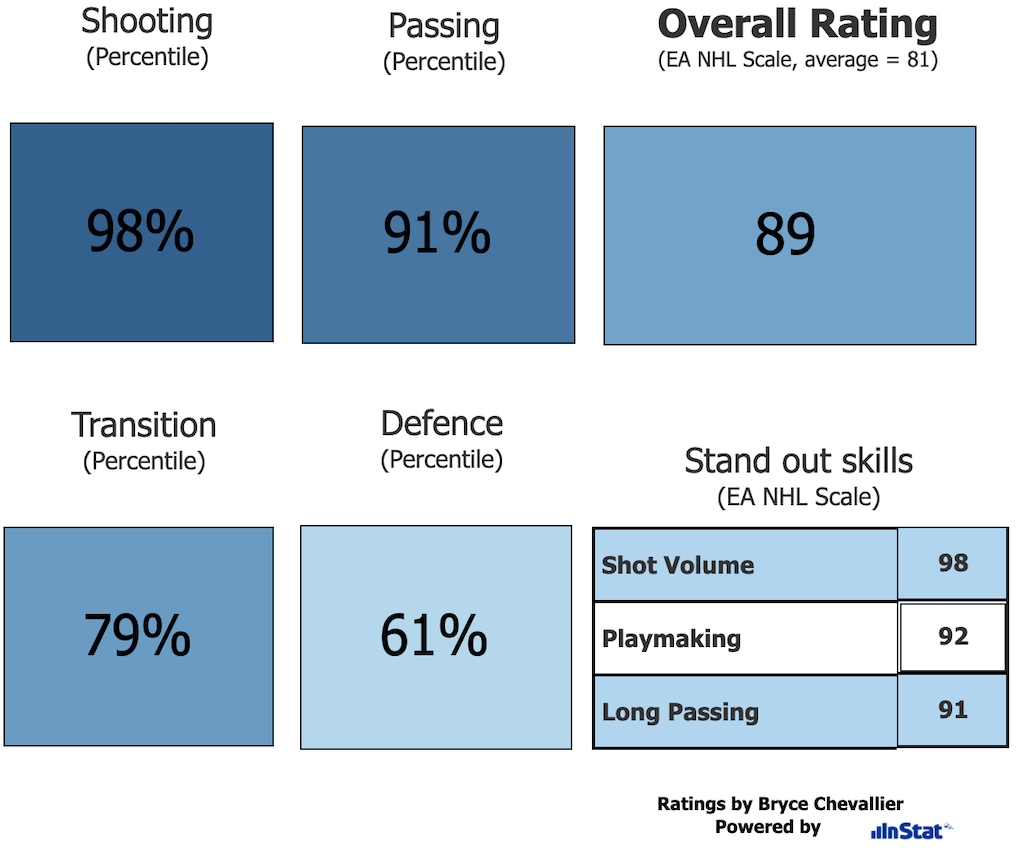The New Jersey Devils’ power play in 2020-21 was a mess, and that’s being generous. They had brought in Mark Recchi last offseason to run the power play alongside head coach Lindy Ruff. But he had a rough first season in that role, as their power play finished the season converting on 14.2 percent of its chances, ranked 28th in the NHL.
It’s hard to blame Recchi solely for the team’s power-play woes. A teamwide COVID outbreak from late January to early February made a tight schedule even tighter. Once the Devils returned to the ice, they played almost four games every six nights until the season ended, severely limiting their practice time to work on special teams. Now with a closer-to-normal schedule on tap for the 2021-22 season, Recchi should have better means to implement the system he wants.
Related: Devils’ Signing of Hamilton Just What They Needed
He’ll also have some new personnel to work with, namely Dougie Hamilton, who the Devils signed to a seven-year, $63 million deal this offseason. He’s one of the best all-around defensemen in the NHL. But his biggest strengths come offensively, and he puts them to particularly good use on the power play. His addition doesn’t mean the Devils will suddenly have a top-five power play in the league, but he should surely help it improve in a big way.
How Hamilton Impacts the Power Play
The Devils’ power play has struggled quite a bit since they made the playoffs in 2017-18. But last season marked a low, as its 28th ranking is the worst it’s been since that playoff appearance. What went wrong for the team’s man advantage? In short, their shot and chance generation was below average to poor.
The Devils averaged 80.03 shot attempts (CF/60) and 5.33 expected goals per 60 minutes (xGF/60), both of which ranked in the bottom five of the league last season. They averaged 37.6 scoring chances and 13.04 high-danger chances per 60 minutes, both of which also ranked in the bottom five of the NHL. So it shouldn’t come as a surprise that they struggled to score with shot and chance generation that weak.

Meanwhile, the Carolina Hurricanes’ power play was a complete 180 from the Devils’ last season. They averaged the second-most CF/60 in the league and the sixth-most xGF/60. When it came to chances, they averaged the fourth-most SCF/60 and the sixth-most HDCF/60. It should come as no surprise that they converted on 25.6 percent of their power plays, good for second in the NHL.
And Hamilton played a big part in that success. The Hurricanes averaged 122.8 CF/60 with him on the ice on the power play last season. That ranked 13th-best among all skaters, and the only defenseman to have a higher rate than him was Cale Makar. Meanwhile, they averaged 8.3 xGF/60 with him on the ice, the fourth-best rate for a defenseman in 2020-21.
It was not just a one-year wonder for Hamilton, either. In his three seasons with the Hurricanes, they averaged 112.63 CF/60 with him on the ice, the fifth-best rate for a defenseman, while his xGF/60 of 7.82 ranked eight-best. A look at his regularized adjusted plus-minus chart shows someone who had a substantial positive impact on the power play:

It’s clear Hamilton made a noticeable difference for the Hurricanes’ power play. It remains to be seen what kind of impact he has for the Devils. But there’s no doubt he has the skill set that will help the team end up with a better than 28th-ranked man advantage. And while he might not quite have the personnel he did with the Hurricanes, he’ll have some help in New Jersey.
What Hamilton Adds to the Power Play
The lack of shot and chance generation was a big part of why the Devils’ power play faltered in 2020-21. But another reason they struggled to get anything going was because of their inability to set up properly in the offensive zone. They were able to carry in the puck effectively, but their ability to get set up was slightly below average (via Corey Sznajder).
Related: Devils’ Hamilton & Graves Make for Ideal Top Defense Pair
One of the best parts of Hamilton’s game is his effectiveness in transition. He’ll be able to help the Devils carry the puck into the offensive zone, but once they gain the zone, he’ll help set things up. He’s one of the best power play quarterbacks in the league. His ability to walk the blue line and operate calmly will give the Devils stability in that role they haven’t had in quite some time.
Another aspect of Hamilton’s game that will help on the power play is his ability to generate offense. This visual from Architecte Hockey, which uses data provided by InStat Hockey, shows Hamilton ranks in the 98th percentile in shooting and the 91st percentile in passing. And as it happens to be, shot volume and playmaking are his standout skills, two traits you’d like to have in a power play quarterback. So it’s a good bet he’ll end up with some strong point totals at 5-on-4 and especially 5-on-3.

Something that also hurt the Devils’ power play last season was the lack of game-breaking personnel. Hamilton fixes that, and the addition of Tomáš Tatar should help if he finds himself on the first power-play unit with Hamilton. The Devils didn’t add anyone else this offseason who can boost the power play, but their roster consists of young players who are still developing. Of course, there’s Jack Hughes. There are a couple of legit shooting threats in Pavel Zacha and Yegor Sharangovich too. They might not be Andrei Svechnikov or Martin Necas, but they can get the job done. And don’t forget Nico Hischier, Jesper Bratt and even Janne Kuokkanen, who’ll all likely have power-play roles too.
With Hamilton on board, the Devils’ power play should see significant improvement in 2021-22. His impact there, plus the tools he’ll provide Recchi, should make things operate much more smoothly. That doesn’t mean the Devils will suddenly have the best power play in the league, or even one that ranks in the top five. But there shouldn’t be any excuse for it to be among the five worst in the NHL. And with Hamilton set to play a major role, it’d be a surprise if that were the case.
* * *
Advanced stats from Natural Stat Trick